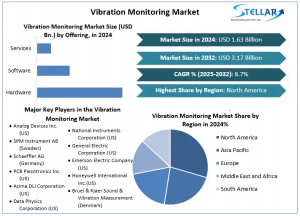Vibration Monitoring Market To Hit USD 3.17 Billion 2032, Expected to Grow at 8.7% From 2025 To 2032
Vibration Monitoring Market size was valued at US$ 1.63 Billion in 2024 and is expected to grow at 8.7% from 2025 to 2032, reaching nearly US$ 3.17 Billion.
Vibration Monitoring Market Overview
A vibration monitoring system collects vibration data on frequency, amplitude, and duration, and can convert that data into actionable information for maintenance groups and asset stakeholders. Vibration monitoring systems offer non-invasive data capture, allowing for early detection of faults while reducing the risks of operational disruption. Vibration monitors are becoming smaller, less expensive, and smarter by utilizing advances in technology with integrated System-on-Chip (SoC), wireless connectivity, and smartphone connectivity. As enterprises are moving from manual inspections of assets to real-time automated monitoring of assets, they are reducing humans, errors, and downtime. Increasingly, companies of all sizes are using vibration monitoring as a process operational modality to mitigate the risks of asset failures, increase operational uptime, and increase plant safety in higher-risk assets and remote locations.
To know the most attractive segments, click here for a free sample of the report: https://www.stellarmr.com/report/req_sample/Vibration-Monitoring-Market/411
Market Dynamics
Growth Drivers
Remote Monitoring Post-COVID: The COVID-19 pandemic impacted industrial operations greatly, creating the urgent need to reduce physical presence at manufacturing plant sites. In the name of safety and to comply with health regulations, industries quickly began adopting real-time, wireless vibration monitoring systems to remotely monitor conditions. These systems enabled maintenance teams to understand the health of equipment away from the site to ensure the plant continued to operate while limiting exposure on-site and unnecessary downtime. This transition has become a permanent means of improving safety and efficiency.
Technology Integration: Technological advancements in artificial intelligence (AI), machine learning (ML), big data analytics, and edge computing have changed vibration monitoring into a powerful predictive analytical tool. AI, ML, big data, and edge computing bestow the following capabilities: automated diagnostics; faster fault detection; infinite data collection, analysis, and storage, and create vibration systems as a collaborative element in Industrial IoT ecosystems to make better-informed data-driven decisions to optimize operational performance.
Restraints
Uncertainty in Forecasting: Concerns about the accuracy of vibration-based systems continue in regard to false signals, noise, and data gaps, creating mistrust from the very experienced technicians who automated diagnostics rely upon.
Resistance to Adoption: This resistance may be driven by the complexity of not just operational processes but also software systems and their limited dynamic systems among these traditional processes for new technologies.
Opportunities
Big Data & Deep Learning: These technologies allow for precise and reliable predictions, deeper fault analysis, and easier monitoring of performance, leading to less total cost of ownership for users.
Integration in Predictive Maintenance: Industry 4.0 strategies will depend on vibration monitoring as part of the process to approach proactive maintenance, which will help reduce unplanned downtime while optimising the use of resources.
Segmentation Analysis
By Offering
Hardware
Software
Services
By Process
Online Vibration Monitoring
Portable Vibration Monitoring
By System
Embedded Systems
Vibration Analyzers
Vibration Meters
By Industry
Oil & Gas (Dominated in 2024; CAGR: 9.3%): Concentrating on reducing widely recognized operational costs and maintaining uptime is driving the demand for continuous vibration monitoring within this vertical.
Power Generation
Mining & Metals
Chemical
Automotive
Aerospace & Defense
Food & Beverage
Marine
Others
Regional Insights
North America is expected to dominate the vibration monitoring market by 2032 as manufacturers embrace predictive maintenance, leverage the presence of leading companies like Honeywell and National Instruments, and meet their strict safety regulations. The European market, too, rapidly converting facilities to automation and having strict energy efficiency regulations, especially in Germany, UK, and France - would be a large regional market for the use of motive and vibration monitoring equipment and services based on this exciting transition. In the Asia Pacific region, the markets for vibration monitoring in China, India and South Korea are robust and expected to continue: due in part to a rapidly growing manufacturing sector and increasing potential for upgrading factories and plants to modern, digitally capable processing and production areas with increased demand for automotive, energy and other consumer products. Middle East & Africa region with oil and gas exploration and infrastructure upgrades will spur demand for vibration monitoring. While South America is maturing as a market opportunity - driven by increased digitization of industrial activity, proactivity from regional governments that reduce or eliminate downtime for unplanned disturbances to production.
To know the most attractive segments, click here for a free sample of the report: https://www.stellarmr.com/report/req_sample/Vibration-Monitoring-Market/411
Competitive Landscape
Market players are actively investing in R&D, launching AI-powered solutions, and forming strategic alliances with industry leaders. These developments aim to improve data accuracy, diagnostics efficiency, and remote monitoring capabilities.
Key Players in the Vibration Monitoring Market:
Analog Devices Inc. (US)
SPM Instrument AB (Sweden)
Schaeffler AG (Germany)
PCB Piezotronics Inc. (US)
Azima DLI Corporation (US)
Data Physics Corporation (US)
Rockwell Automation, Inc. (US)
National Instruments Corporation (US)
General Electric Corporation (US)
Emerson Electric Company (US)
Honeywell International Inc. (US)
Bruel & Kjaer Sound & Vibration Measurement (Denmark)
Meggitt PLC (UK)
Summary
The Vibration Monitoring Market, valued at USD 1.63 billion in 2024, is projected to reach USD 3.17 billion by 2032, growing at a CAGR of 8.7%. This growth is fueled by the rising need for predictive maintenance, real-time monitoring, and operational efficiency across industries like oil & gas, power generation, and automotive. Technological advancements in AI, ML, and IoT are transforming vibration monitoring into a key element of smart maintenance systems. Post-COVID remote monitoring trends and digital transformation are accelerating adoption. However, challenges such as data reliability concerns and resistance to change remain. Hardware, software, and services form the core offerings, with applications in embedded systems, analyzers, and meters. North America leads the market due to strong industrial automation and safety standards, followed by Europe and Asia-Pacific. Major players include Honeywell, National Instruments, GE, and Emerson. Future opportunities lie in expanding affordable AI-integrated systems for SMEs and deepening integration into Industry 4.0 frameworks.
Related Reports:
Aerospace and Life Sciences TIC Market: https://www.stellarmr.com/report/aerospace-and-life-sciences-tic-market/2430
Electric Fuse Market: https://www.stellarmr.com/report/electric-fuse-market/2394
Instrument Cluster Market: https://www.stellarmr.com/report/instrument-cluster-market/2388
Earphones and Headphones Market: https://www.stellarmr.com/report/earphones-and-headphones-market/2375
Electronics Ceramics and Electrical Ceramics Market: https://www.stellarmr.com/report/electronics-ceramics-and-electrical-ceramics-market/2373
About Stellar Market Research:
Stellar Market Research is a multifaceted market research and consulting company with professionals from several industries. Some of the industries we cover include medical devices, pharmaceutical manufacturers, science and engineering, electronic components, industrial equipment, technology and communication, cars and automobiles, chemical products and substances, general merchandise, beverages, personal care, and automated systems. To mention a few, we provide market-verified industry estimations, technical trend analysis, crucial market research, strategic advice, competition analysis, production and demand analysis, and client impact studies.
Contact Stellar Market Research:
S.no.8, h.no. 4-8 Pl.7/4, Kothrud,
Pinnac Memories Fl. No. 3, Kothrud, Pune,
Pune, Maharashtra, 411029
sales@stellarmr.com
Lumawant Godage
Stellar Market Research
+ +91 9607365656
email us here
Visit us on social media:
LinkedIn
Instagram
X
Legal Disclaimer:
EIN Presswire provides this news content "as is" without warranty of any kind. We do not accept any responsibility or liability for the accuracy, content, images, videos, licenses, completeness, legality, or reliability of the information contained in this article. If you have any complaints or copyright issues related to this article, kindly contact the author above.
Fresh Growth in Laundry Detergents Market: To Reach USD 105.53 Billion by 2032, Fueled by Innovation & Sustainability
MQube Powers UK’s First AI-Accessible Mortgage Affordability Calculator
Pasta Sauces Market to Hit USD 5.37 Billion by 2032 at 6.10% CAGR Driven by Demand for Non-GMO Ingredients
Więcej ważnych informacji
 Jedynka Newserii
Jedynka Newserii

 Jedynka Newserii
Jedynka Newserii

Polityka

Polska może się stać Doliną Krzemową Europy. Potrzeba jednak wsparcia finansowego start-upów i mocniejszej deregulacji
Polskie start-upy skoncentrowane są głównie na rozwoju nowoczesnych technologii informatycznych i cyfrowych. Wyraźny nacisk na oprogramowanie i aplikacje oraz big data i data science wskazuje na silne zainteresowanie narzędziami analitycznymi i rozwiązaniami wspierającymi transformację cyfrową w różnych branżach – wynika z raportu „Rynek start-upów w Polsce. Trendy technologiczne”, który został opracowany w 2024 roku w MRiT. Zdaniem europarlamentarzystów Polska ma szansę się stać Doliną Krzemową, jednak rozwój start-upów blokowany jest m.in. przez ograniczony dostęp do finansowania oraz niekorzystne i nadmierne regulacje.
Transport
Na półmetku wakacji ceny paliw na stacjach nie powinny się wyraźnie zmienić. Znaczące różnice między regionami i stacjami

W sierpniu ceny benzyny, oleju napędowego i autogazu powinny pozostać na poziomach z lipca – uważa ekspertka rynku z firmy Reflex. Wyższe będą zawsze na stacjach premium, tych, które oferują bogatszą ofertę dodatkową, promocje dla uczestników programu lojalnościowego, oraz w regionach, w których tradycyjnie paliwa są droższe ze względu np. na wyższą siłę nabywczą mieszkańców. Różnice mogą sięgać kilkudziesięciu groszy na litrze. Obszary, wokół których te wartości oscylują, zależą z kolei od sytuacji globalnej. Warto patrzeć na sytuację na Bliskim Wschodzie i w Ukrainie.
Polityka
A. Mularczyk (PiS): Nawiązanie poważnego dialogu z Niemcami jest konieczne nie tylko w kontekście reparacji. Powinien być podpisany traktat polsko-niemiecki

– Nie wystarczy jednorazowy gest czy inicjatywa. To musi być podjęcie dialogu, być może też przygotowanie nowej umowy bilateralnej, nowego traktatu polsko-niemieckiego, który regulowałby wszystkie obszary, które wynikały ze skutków II wojny światowej – mówi Arkadiusz Mularczyk, poseł do Parlamentu Europejskiego z PiS-u. Podkreśla, że proces ten nie będzie łatwy, bo wymaga konsekwencji i stanowczości, ale widzi szansę w prezydenturze Karola Nawrockiego, który już zadeklarował kontynuację starań w tym zakresie. Zdaniem europosła wsparciem w polsko-niemieckim dialogu może być administracja Donalda Trumpa.
Partner serwisu
Szkolenia

Akademia Newserii
Akademia Newserii to projekt, w ramach którego najlepsi polscy dziennikarze biznesowi, giełdowi oraz lifestylowi, a także szkoleniowcy z wieloletnim doświadczeniem dzielą się swoją wiedzą nt. pracy z mediami.




![Nestlé w Polsce podsumowuje wpływ na krajową gospodarkę. Firma wygenerowała 0,6 proc. polskiego PKB [DEPESZA]](https://www.newseria.pl/files/1097841585/fabryka-nesquik_1,w_85,r_png,_small.png)




.gif)

 |
| |
| |
|